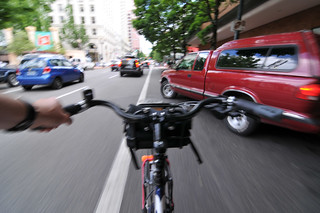A new study by researchers at the University of British Columbia and published in the American Journal of Public Health shows that physcially separated, bicycle-specific infrastructure can lead to much lower risk of injury for people riding bicycles.
Here’s more on the study from Atlantic Cities:
As it turns out, infrastructure really matters. Your chance of injury drops by about 50 percent, relative to that major city street, when riding on a similar road with a bike lane and no parked cars. The same improvement occurs on bike paths and local streets with designated bike routes. And protected bike lanes – with actual barriers separating cyclists from traffic – really make a difference. The risk of injury drops for riders there by 90 percent.
Intuitively, it shouldn’t come as any surprise to find that research shows separating people on bikes from motor vehicle traffic leads to fewer injuries. But there’s a group of people in the U.S. who feel that people on bikes are safest when they mix with car traffic. Even in comments here on BikePortland, it’s common to hear from folks who don’t like the idea of being locked into using separated bikeways (either by design or by law) when they’d rather “take the lane”.
In the past, I’ve heard that one reason for City Hall’s reluctance to push for more physically separated bikeways was precisely because there seemed to be infighting from the “bike community” about whether they were wanted or not. (Unfortunately, local politicians still seem to wait for a mythical, 100% consensus from the “bike community” before they push for bike-specific projects.)
This new research should be welcome ammunition for advocates and city planners who support more separated bike infrastructure.
Here in Portland — despite knowing for years that separation is imperative to reach our cycling usage goals — we’ve had a bit of separation anxiety. While we do have some bright spots of separated infrastructure, it has happened primarily where it was politically and technically easy to pull off. The plans to revamp NE Multnomah through the Lloyd District with more protected bikeways are a positive step forward. That project is great sign of progress and a promising omen for the future; but even that came only after major public outcry from people who wanted better bike access than PBOT originally proposed.
Last year, when I asked Portland Mayor Sam Adams’ transportation policy director Catherine Ciarlo about our progress toward more separation, even she acknowledged our effort was only good for “bronze”. Instead of pushing for fully separated, connected bikeways in the urban core, Ciarlo’s response was very telling. “The challenge is to figure out how to achieve separation in creative or economical ways,” she said. Ciarlo cited neighborhood greenways (which are shared environments on residential streets) as an example of this creativity. She also cited progress on signal timing as one way PBOT is separating bicycle traffic.
Bike boulevards and bike-oriented signal technology will only get us so far. The unmet challenge in Portland is to map out a network of streets in the central city that have dedicated and physically separated bicycle access. The City has an obligation to provide the same level of comfort and convenience for people riding bicycles as they currently offer people on foot and in cars, buses, streetcars, and light rail trains.
As evidenced by PBOT’s recent revelation that collisions have gone way up at several downtown intersections where they opted to use only paint as a means of separation, this research couldn’t have come at a better time. Of course, all the knowledge in the world means nothing unless it’s acted upon.


